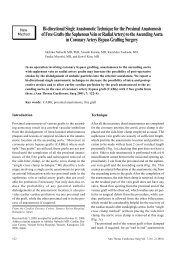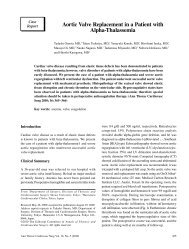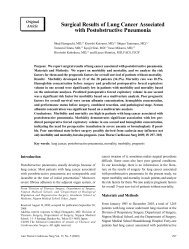Epidermal Growth Factor Receptor Gene Mutations in Early ... - Atcs.jp
Epidermal Growth Factor Receptor Gene Mutations in Early ... - Atcs.jp
Epidermal Growth Factor Receptor Gene Mutations in Early ... - Atcs.jp
You also want an ePaper? Increase the reach of your titles
YUMPU automatically turns print PDFs into web optimized ePapers that Google loves.
Nakamura et al.<br />
AB<br />
Fig. 1. Results of s<strong>in</strong>gle-strand conformation polymorphism<br />
(SSCP) analysis.<br />
The DNA strand with the mutation shows a mobility shift on a<br />
gel.<br />
A: SSCP analysis of exon 19 carried out at 10˚C for 4 h. Mobility<br />
shift is observed <strong>in</strong> cases 2, 6, 12, 25, and 26.<br />
B: SSCP analysis of exon 21 carried out at 10˚C for 4 h. Mobility<br />
shift is observed <strong>in</strong> cases 1, 7, and 11. All of these<br />
abnormal DNA strands were sequenced to identify the altered<br />
bases.<br />
growth) are regarded as more aggressive cancers. This<br />
classification is widely considered to accurately depict<br />
the diverse array of pulmonary adenocarc<strong>in</strong>omas. We<br />
therefore sought to clarify when EGFR mutation occurred<br />
dur<strong>in</strong>g development of small pulmonary adenocarc<strong>in</strong>omas,<br />
us<strong>in</strong>g the Noguchi’s classification to estimate relative<br />
time po<strong>in</strong>ts <strong>in</strong> tumor development.<br />
Materials and Methods<br />
Patient characteristics<br />
Resected lung cancer tissues from 30 patients who underwent<br />
lobectomy and systematic lymph node dissection<br />
<strong>in</strong> Tokyo Medical University Hospital were studied<br />
with respect to EGFR gene mutations. Histologic types<br />
<strong>in</strong>cluded 25 adenocarc<strong>in</strong>omas and 5 other carc<strong>in</strong>omas<br />
<strong>in</strong>clud<strong>in</strong>g 2 squamous cell carc<strong>in</strong>omas, 2 large cell carc<strong>in</strong>omas,<br />
and 1 small cell carc<strong>in</strong>oma. Noguchi’s pathologic<br />
classification was applied to all adenocarc<strong>in</strong>omas,<br />
<strong>in</strong>clud<strong>in</strong>g some tumors larger than 20 mm. Adenocarc<strong>in</strong>omas<br />
<strong>in</strong>cluded 2 <strong>in</strong> type A, 1 <strong>in</strong> type B, 7 <strong>in</strong> type C, 10 <strong>in</strong><br />
type D, 2 <strong>in</strong> type E, and 3 <strong>in</strong> type F. Pathologic (p-) stages<br />
of the 30 carc<strong>in</strong>omas accord<strong>in</strong>g to <strong>in</strong>ternational stag<strong>in</strong>g<br />
criteria 11) were IA <strong>in</strong> 15, IB <strong>in</strong> 5, and IIA to IIIB <strong>in</strong> 10.<br />
The p-IA tumors <strong>in</strong>cluded 8 small adenocarc<strong>in</strong>omas with<br />
a largest dimension below 20 mm. Written <strong>in</strong>formed consent<br />
for genetic analysis of the resected tumor was obta<strong>in</strong>ed<br />
from all patients. In the operat<strong>in</strong>g room, immediately<br />
upon resection of a pulmonary lobe conta<strong>in</strong><strong>in</strong>g a<br />
primary lung cancer, about 500-mg sample was removed<br />
from the tumor, immersed <strong>in</strong> liquid nitrogen, and stored<br />
at −80˚C until genetic study.<br />
Detection of the EGFR gene mutation<br />
Genomic DNA was extracted from the stored tumor us<strong>in</strong>g<br />
a REDExtract -N-Amp Tissue PCR kit (Sigma, St.<br />
Louis, MO). The three exons <strong>in</strong> the EGFR gene (exons<br />
18, 19, and 21) reported to <strong>in</strong>clude frequent mutation sites<br />
were amplified by polymerase cha<strong>in</strong> reaction (PCR).<br />
Primer sequences of 5´-AGGTGACCCTTGTC-<br />
TCTGTGTTCT-3´ and 5´-CACCAGACCATGA-<br />
GAGGCCCTGCG-3´ were used to amplify 216 base pairs<br />
<strong>in</strong> exon 18 by two-step PCR at an anneal<strong>in</strong>g temperature<br />
of 68˚C; 5´-GATCACTGGGCAGCATGTGGCACC-3´<br />
and 5´-TGGACCCCCACACAGCAAAGCAGA-3´ to<br />
amplify 199 base pairs <strong>in</strong> exon 19 by two-step PCR at<br />
anneal<strong>in</strong>g temperature of 68˚C; and 5´-TTCCC-<br />
ATGATGATCTGTC-3´ and 5´-ATGCTGGCTGA-<br />
CCTAAA-3´ to amplify 232 base pairs <strong>in</strong> exon 21 by<br />
three-step PCR at an anneal<strong>in</strong>g temperature of 55˚C.<br />
Amplified sequences with<strong>in</strong> each exon <strong>in</strong>itially were<br />
screened for mutations by s<strong>in</strong>gle-strand conformation<br />
polymorphism (SSCP) analysis us<strong>in</strong>g 14% polyacrylamide<br />
gels. Samples were electrophoresed at 72 V/cm<br />
under two different conditions, 10˚C for 4 h and 20˚C for<br />
2 h. Isolated DNA strands show<strong>in</strong>g a mobility shift on<br />
gels were cut from gels, and these isolated DNA strands<br />
were sequenced us<strong>in</strong>g cycle sequenc<strong>in</strong>g kit (BigDye Term<strong>in</strong>ator<br />
version 3.1, Applied Biosystems, Foster City, CA)<br />
<strong>in</strong> a DNA analyzer (Applied Biosystems 3730x).<br />
Statistical analysis<br />
Differences <strong>in</strong> distribution of EGFR mutations between<br />
two groups were tested by Fisher’s exact probability test.<br />
88<br />
Ann Thorac Cardiovasc Surg Vol. 13, No. 2 (2007)








